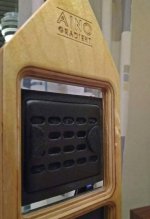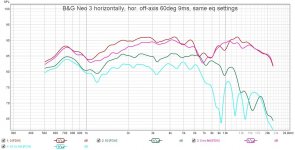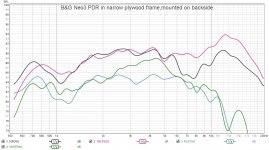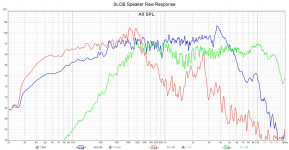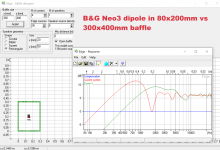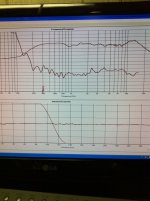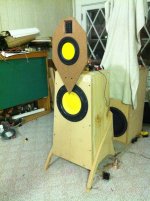Baffle dimensions are very important in dipole radiation (dipole loss of low freq)
xrk's baffle looks much wider than others here, and side panels add to virtual width too. Effect of waveguide is guite small with dipoles (in smaller range of freq)
Factory datasheet measurements are always in much much wider baffle (virtually infinite baffle)
VCAD2 and even The Edge can simulate different baffels and monopole/dipole effect
http://www.tolvan.com/index.php?page=/edge/edge.php
https://kimmosaunisto.net/
xrk's baffle looks much wider than others here, and side panels add to virtual width too. Effect of waveguide is guite small with dipoles (in smaller range of freq)
Factory datasheet measurements are always in much much wider baffle (virtually infinite baffle)
VCAD2 and even The Edge can simulate different baffels and monopole/dipole effect
http://www.tolvan.com/index.php?page=/edge/edge.php
https://kimmosaunisto.net/
On my XSD speaker, the baffle is 12in wide and where the tweeter is, there are no extra wings. The shallow waveguide had a nice effect of increasing the lower bandwidth and smoothing the upper response. When I used the same waveguide on the sealed back version of the PTT2522-4 on a speaker with a beveled baffle, it looked like this:

Here’s the cabinet with beveled baffle:


Here’s the cabinet with beveled baffle:

HOW LOW can the dipole tweeter w/ wave guide be crossed over, using high order X/over (LR4order)? Thanks for any useful info.
The advantage of crossing low is to match directivity with a midwoofer……this only applies to a direct radiator. With a dipole, directivity is established by the driver and baffle size with the rear wave cancellations. These types of drivers also have pretty poor vertical directivity so crossing low…..well…..you’ll be either sitting or standing while listening but not both. Cross these very high to a small midwoofer around 3.5khz…….you can push a 180mm to this with a well damped paper cone midwoofer.
I will sit on tweeter axis, 39"H!!
(I prefer to sit while listening 🙂
There is a pair of 3" T.B. Full- ranges to go above & below (MTM, 7.25" C-T-C) the PT2522/ waveguide and my test baffle is 12" wide by 48" tall. I have an LR24dB/ octave crossover with sets of fixed frequency modules for 2.5kHz(or 3k,3.5k) for mids to tweeter transition.
Bass will be handled by a monopole enclosure (hybrid).
Anyone here have experience using this tweeter so low?
(I prefer to sit while listening 🙂
There is a pair of 3" T.B. Full- ranges to go above & below (MTM, 7.25" C-T-C) the PT2522/ waveguide and my test baffle is 12" wide by 48" tall. I have an LR24dB/ octave crossover with sets of fixed frequency modules for 2.5kHz(or 3k,3.5k) for mids to tweeter transition.
Bass will be handled by a monopole enclosure (hybrid).
Anyone here have experience using this tweeter so low?
I've just been informed that this dipole tweeter has a bit of a distortion bump at ~2,000Hz; However, I hope 2.5kHz/24dB will still be okay since I'm also using a 30uF MPK cap wired in series to protect the tweeter from turn-on thumps. This also acts as a 1st Order filter at ~1.2-1.3 kHz (an octave below X/O) and should help to further reduce the tweeter distortion.
Any advice from experience here will be appreciated.
Any advice from experience here will be appreciated.
You can use the bigger version of this tweeter if you want to cross lower. For the PT2522, my opinion is that you shouldn’t cross it below 3kHz. Ribbons, AMTs, and planars of this size are all typically crossed 3kHz or higher. If you want 1.5 to 2.5kHz, that’s what dome tweeters or larger AMTs are for.
PT6825-8 goes down to 300Hz:
https://www.parts-express.com/pedocs/specs/272-126--grs-pt6825-8-spec-sheet.pdf
ESS AMT can go down to 700Hz.
PT6825-8 goes down to 300Hz:
https://www.parts-express.com/pedocs/specs/272-126--grs-pt6825-8-spec-sheet.pdf
ESS AMT can go down to 700Hz.
- Home
- Loudspeakers
- Multi-Way
- Strange response from GRS PT2522-4 in open baffle
